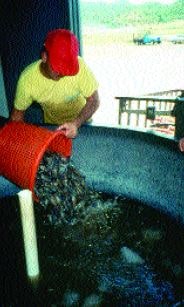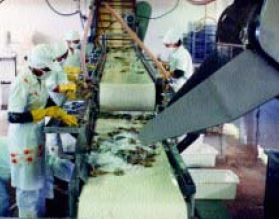7.2 Handling your prawns after harvest and ensuring good product quality
In general, the value of your harvested product will depend on its quality. Speed during and after harvesting, getting the prawns on ice and out of the sun, and care in handling to prevent physical damage, will all reap valuable dividends. Farmed prawns should be bet ter than the wild-caught product in every way and it is up to you to see that your hard-won harvest does not deteriorate through poor harvesting and post-harvest procedures.
The handling of freshwater prawns after harvesting was thought to be beyond the scope of the original FAO manual on freshwater prawn culture; very few recommendations were made at that time. However, much more is now known about the effects of handling on prawn quality (and therefore value). The following section of the manual has been derived mainly from the work of Madrid and Phillips (2000) and especially from the expe rience gained in a Costa Rican farm operated by one of those authors.
HANDLING PRAWNS TO BE SOLD FRESH
If you intend to sell your prawns fresh (instead of selling them alive or frozen) you will need to keep them very cool, after the pond-side pre-processing described earlier has been done. You should not allow your prawns to die from asphyxia by leaving them out of water. Harvesting mud as well as prawns is a source of microbial contamination. You should not place live prawns straight onto ice; this results in a slow decline in body temperature, caus es stress, and accelerates the deterioration process which occurs after death. As noted in the harvesting section of this manual, prawns which are not going to be sold live should immediately be washed in clean water and killed in a mixture of water and ice at 0°C (Figure 95). To kill a batch of 50 kg of prawns, for example, immerse them in 50 L of water and 80 kg of ice for 30 minutes. Finally, you should wash them in chlorinated water (5 ppm active chlorine). If supplies are locally available, full-strength seawater which has been chlorinated has been found to reduce the incidence of ‘mushiness’.
After killing, remove your prawns from the cold water and immediately place them in isothermal boxes, with alternate layers of ice and prawns, placing ice in the first and last layers. Make sure your ice has been made from clean chlorinated water! Further informa tion on the use of ice can be found in another FAO publication (Graham, Johnston and Nicholson 1993). You can then refrigerate your prawns at 0°C for short-term on-farm stor age for sale as fresh prawns, or for transport to market or processing facilities (-10°C is not necessary and is much more expensive in terms of equipment and running costs). You are recommended not to keep prawns refrigerated at 0°C for more than 3 days; 5 days is the absolute maximum. Do not use large blocks of ice for storage or transport on ice because they will damage the prawns; use flaked or crushed ice.
Figure 95
If you are not marketing your freshwater prawns alive, you should kill-chill them in a bath of iced water immediately after harvesting to get the best quality (Puerto Rico)

SOURCE: DENIS LACROIX
HANDLING PRAWNS TO BE SOLD FROZEN
If you are not going to sell your prawns within 5 days of harvest, which is considered to be their maximum practical refrigerated shelf life, you need to freeze them immediately. These prawns need the same care and attention as those sold fresh. Always remember that freezing does not improve the quality of the prawns; at best it will preserve them in the quality they show at the time of freezing. Freezing at temperatures below -10°C is essential; storage at -20°C or below is recommended; storage at -30°C is ideal. To avoid physical damage to the muscle structure of the prawns, it is recommended that the freezing tem perature passes from -1°C to -5°C as rapidly as possible (not more than 2 hours). This decreases the production of ‘drip’ (leak) at the moment of thawing, and keeps the prawns looking and tasting the same as before freezing. If you freeze them more slowly it will cause large crys tals to form in the water between the cells of the animals and increase ‘drip’. Keeping prawns frozen on-farm is generally not good practice, except on very large farms where spe cialist equipment has been installed. Otherwise it is best to sell them to professional processors who know how to care for the product properly.
Despite this advice, domestic freezers are often used by small farmers to freeze and store prawns. This does increase their shelf life but it can damage the texture of the flesh. You must not try to freeze prawns by placing them straight into domestic freezers because it results in the most frequent criticisms of prawns, namely that they are ‘mushy’. Domestic equipment should only be used for very small amounts of prawns that are already very cold when first placed into the freezer. It is important that you keep the prawns in contact with the base of the ‘freezer’, or with the shelves where the refrigerant liquid passes. As the thick ness of the layers of prawns increases, the freezing time increases in a geometric proportion. When you withdraw prawns from a freezer, do not let any which you do not immediately intend to use thaw out. Replace them into the freezer before they thaw.
Figure 96
Freshwater prawns need sorting while being processed (Brazil)

SOURCE: MICHAEL NEW
Newly frozen prawns should be put in the back of the stor age facilities and the prawns at the front used first. This technique for ensuring fresh ness is sometimes referred to as ‘FIFO’ (first in, first out). You must always avoid the alternatives, which could be called ‘FILO’ (first in, last out) or ‘FISH’ (first in, still here).
If your farm is large and you intend to freeze your own prawns the best solution is to use special processing and
freezing equipment and packaging (Figures 96 and 97). This topic is beyond the scope of this manual but an introduction can be found in Madrid and Phillips (2000) and more details in another FAO publication (Johnston, Nicholson, Roger and Stroud 1994).
If your market prefers it, you can pre-cook your prawns before freezing (Madrid and Phillips 2000). The appearance of cooked versus uncooked prawns is shown in Figure 98.
HANDLING FOR LIVE SALES
Sometimes you will want to sell your prawns alive, either at your farm gate or after trans port to markets and (especially) restaurants. These prawns also require careful, but dif ferent handling; the techniques are similar to those used to sell other live aquatic products. You will need to change your holding and transport water regularly to eliminate ammonia build-up. Keep the dissolved oxygen level above 5 ppm with aeration. Prawns to be trans ported live should be washed in non-chlorinated clean water and then brought to the same temperature that can be maintained during transport to prevent thermal shock through sudden transfer into water of a totally different temperature. It is recommended that you keep the transport temperature at about 20-22°C. Use small amounts of ice, if necessary, to keep this temperature constant. Transport techniques similar to those used to transport prawn postlarvae from hatcheries to distant grow-out facilities by road transport (as
Figure 97
Package your prawns attractively (Mauritius)
Figure 98
Freshly harvested (blue) Macrobrachium rosenbergii can be cooked (pink) at the pond-side to provide a tasty barbeque (Brazil)

SOURCE: YANN VON ARNIM SOURCE: MICHAEL NEW
described earlier in this manual) are suitable. In general, restaurants and shops or mar ket stalls selling live prawns will have aquariums to display them. You are recommended, for best quality, not to keep live animals in these aquaria for more than five days before sale and consumption.